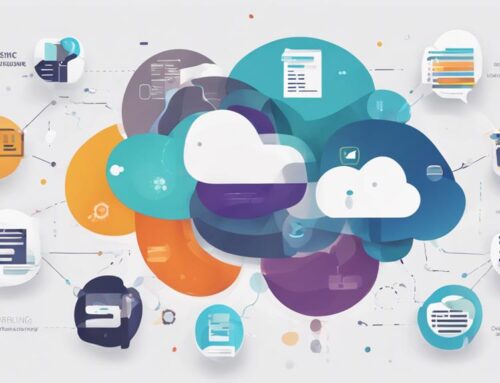When considering data management, you must be mindful of various best practices in outsourcing data management to ensure the security and integrity of your data. From selecting the right vendors to implementing robust compliance measures and diligently monitoring SLAs, each step plays a vital role in safeguarding your information. However, there are more nuanced strategies and techniques to explore in this complex landscape that can elevate your outsourcing endeavors to the next level.
Vendor Selection Criteria
When considering the critical aspect of vendor selection criteria for outsourcing data management, you must delve into the intricate process of identifying the most suitable partners to entrust with your data. Data governance plays a pivotal role in this decision-making process. Ensuring that the vendor has robust data governance policies in place is essential to maintaining the integrity and security of your data throughout the outsourcing relationship.
Outsourcing benefits, such as cost savings, access to specialized expertise, and increased operational efficiency, are key drivers for organizations looking to outsource their data management functions. However, these benefits can only be fully realized if the vendor you select aligns with your specific business requirements and values. Conducting thorough due diligence, evaluating the vendor’s track record, security measures, and scalability, are all critical factors to consider when choosing a partner for outsourcing data management.
Data Privacy Compliance Measures
When it comes to data privacy compliance measures, understanding privacy laws is crucial for ensuring your data management practices meet legal requirements. Encryption and security protocols play a key role in safeguarding sensitive information from unauthorized access or breaches. Implementing robust data access controls helps limit who can view, edit, or delete data, enhancing overall data protection measures.
Privacy Laws Overview
To ensure compliance with data privacy laws, it is crucial for organizations to have a comprehensive understanding of the regulations that govern the protection of personal information. Data protection is at the core of these privacy laws, which aim to safeguard sensitive data from unauthorized access or disclosure. Compliance standards set by various regulations, such as the General Data Protection Regulation (GDPR) and the Health Insurance Portability and Accountability Act (HIPAA), require organizations to implement specific measures to protect personal information.
Under these privacy laws, organizations must obtain explicit consent before collecting personal data, ensure the security of the information through proper storage and transmission protocols, and provide individuals with the right to access, correct, or delete their data. Failure to comply with these regulations can result in severe penalties, including fines and damaged reputation. Therefore, it is essential for organizations to stay informed about the evolving landscape of privacy laws and continuously update their data management practices to meet compliance standards.
Encryption and Security
Having a robust understanding of privacy laws is fundamental in ensuring the protection of personal information within organizations. When it comes to encryption and security in data management, implementing strong data encryption protocols and cybersecurity measures is crucial. Secure data storage is a key component of safeguarding sensitive information. Encryption standards must be followed to prevent unauthorized access to data.
Data encryption protocols involve converting data into a code to prevent unauthorized access. Implementing robust cybersecurity measures, such as firewalls and intrusion detection systems, adds an extra layer of protection against cyber threats. Secure data storage practices ensure that information is kept safe from breaches and cyber-attacks.
Adhering to encryption standards, such as AES (Advanced Encryption Standard) and SSL (Secure Sockets Layer), helps maintain the confidentiality and integrity of data. Regularly updating encryption protocols and cybersecurity measures is essential to stay ahead of evolving threats and compliance requirements. By prioritizing encryption and security measures, organizations can effectively protect sensitive information and uphold data privacy compliance standards.
Data Access Control
Data access control plays a critical role in ensuring data privacy compliance measures are effectively implemented within organizations. As part of robust data governance practices, access control restrictions are essential to safeguard sensitive information from unauthorized access. By defining and enforcing access levels based on job roles and responsibilities, organizations can prevent data breaches and ensure compliance with data privacy regulations.
Effective data access control involves implementing strict user authentication mechanisms, such as multi-factor authentication and role-based access control. This ensures that only authorized personnel have access to specific data sets, minimizing the risk of data leaks or misuse. Regular audits and monitoring of access logs are also crucial components of data access control, allowing organizations to track who accessed what data and when, identifying any suspicious activities promptly.
SLA Monitoring and Enforcement
To effectively manage outsourced data processes, you must prioritize timely SLA tracking to ensure service level agreements are met. Analyzing performance metrics is crucial in identifying areas for improvement and making data-driven decisions. Adhering to escalation protocols guarantees swift resolution of any SLA breaches, maintaining the quality and efficiency of data management operations.
Timely SLA Tracking
Adhering to timely SLA tracking practices is paramount for effective data management outsourcing. SLA compliance ensures that service providers meet agreed-upon performance levels, and timely tracking is crucial for this. By consistently monitoring SLAs, you can quickly identify any deviations and take corrective actions promptly. Performance monitoring plays a vital role in guaranteeing that the service provider meets the service level commitments specified in the SLA.
To achieve successful SLA tracking, establish clear communication channels with your service provider to receive regular updates on performance metrics. Implement automated monitoring tools to streamline the tracking process and receive real-time data on SLA compliance. Regularly review performance reports and address any deviations from the agreed-upon SLAs promptly. Timely SLA tracking not only ensures that service levels are met but also allows for proactive measures to be taken to prevent potential issues from escalating. By prioritizing timely SLA tracking, you can maintain a high level of service quality in your data management outsourcing endeavors.
Performance Metrics Analysis
When analyzing performance metrics in the context of outsourcing data management, the focus shifts to the meticulous monitoring and enforcement of Service Level Agreements (SLAs). Ensuring data quality is crucial in this process, as it directly impacts the efficiency of operations. By establishing clear metrics for data quality, such as accuracy, completeness, and consistency, you can effectively measure the performance of the outsourced data management team.
Process efficiency is another key aspect to consider when analyzing performance metrics. By tracking metrics related to process efficiency, such as turnaround times, error rates, and adherence to standardized procedures, you can identify areas for improvement and streamline operations. Monitoring these metrics allows you to proactively address any issues that may arise, ensuring that the outsourced data management team is meeting the agreed-upon SLAs.
Escalation Protocol Adherence
Monitoring and enforcing Service Level Agreements (SLAs) is a critical aspect of outsourcing data management. When it comes to Escalation Protocol Adherence, ensuring the effectiveness of escalation protocols is paramount. Proper communication strategies play a crucial role in this process. Escalation protocol training is key to equip staff with the necessary skills to address issues promptly and efficiently. Performance evaluation should be conducted regularly to gauge the adherence to escalation protocols and identify areas for improvement.
Contract Negotiation Strategies
Negotiating contracts for outsourcing data management services requires finesse and attention to detail. When engaging in contract negotiation strategies, consider the following:
- Clear Scope Definition: Clearly outline the services to be provided, ensuring both parties have a shared understanding to avoid misinterpretation later on.
- Service Level Agreements (SLAs): Define measurable SLAs for performance, availability, and response times to ensure the outsourced provider meets your business needs effectively.
- Risk Assessment: Conduct a thorough risk assessment to identify potential risks associated with the outsourced data management services and establish mitigation strategies.
- Cost Analysis: Perform a detailed cost analysis to ensure transparency in pricing, including all potential costs such as setup fees, maintenance, and additional services.
Data Management Strategy Planning
Transitioning from contract negotiation to data management strategy planning requires a strategic approach that aligns with your organization’s long-term goals and data management objectives. When planning your data management strategy, consider resource allocation to ensure that you have the necessary tools, technology, and personnel to effectively manage and secure your data. It is crucial to establish a robust data governance framework that outlines policies, procedures, and responsibilities for managing data quality, security, and compliance.
Effective data governance will help you maintain data integrity, improve decision-making processes, and ensure regulatory compliance. By implementing clear guidelines for data access, usage, and maintenance, you can mitigate risks associated with data breaches and unauthorized access. Additionally, developing a data management strategy that aligns with your organization’s overall objectives will enhance operational efficiency and support business growth.
Performance Metrics Tracking
To effectively track the performance metrics of your data management processes, it is essential to establish clear and measurable key performance indicators (KPIs) that align with your organization’s data management objectives. Data quality assessment and trend analysis play a crucial role in evaluating the effectiveness of your data management practices. When tracking performance metrics, consider the following:
- Define Relevant KPIs: Identify KPIs that directly impact your data management goals and objectives to ensure accurate performance tracking.
- Regular Monitoring and Analysis: Continuously monitor and analyze the performance metrics to detect trends and areas for improvement promptly.
- Implement Process Improvement: Utilize the insights gained from performance metrics tracking to enhance data management processes and efficiency.
- Optimize Resources: Identify opportunities to optimize resources based on performance metrics to streamline operations and maximize productivity.
Data Breach Response Protocols
When it comes to data breach response protocols, your organization must establish clear incident notification procedures to ensure swift and effective communication in the event of a security breach. Having robust data recovery strategies in place is crucial for minimizing the impact of a breach and safeguarding sensitive information. Additionally, providing comprehensive employee training on data security protocols is essential to enhance awareness and readiness in handling potential breaches.
Incident Notification Procedures
Implementing effective incident notification procedures is crucial in maintaining a secure data management system. When it comes to incident response and communication plans, having a well-defined strategy can make a significant difference in mitigating the impact of data breaches. Here are some key emotional triggers to consider:
- Transparency: Being transparent in your incident notifications can help build trust with your customers and stakeholders, showing them that you take data security seriously.
- Timeliness: Promptly notifying relevant parties about a data breach demonstrates your commitment to addressing issues quickly and minimizing potential damages.
- Empathy: Showing empathy in your communication can help reassure affected individuals that you understand the impact the incident may have had on them.
- Clarity: Providing clear and concise information in your notifications can help recipients understand the situation better and know what steps to take next.
Data Recovery Strategies
Data recovery strategies are a critical component of any comprehensive data breach response protocol. Implementing robust backup solutions is essential to ensure that in the event of a cyber incident, your organization can recover data swiftly and minimize disruptions. It is advisable to regularly back up your data and store it securely off-site or in the cloud to prevent data loss in case of a disaster.
Disaster recovery planning should be a central focus of your data recovery strategy. Establish clear protocols for restoring data, testing the recovery process, and ensuring that all critical systems are included in your backup solutions. Having a well-defined disaster recovery plan will enable your organization to respond effectively to data breaches and resume normal operations promptly.
Employee Training Requirements
To fortify your organization’s defense against data breaches, focusing on employee training requirements is paramount. Implementing robust data breach response protocols through comprehensive training can significantly reduce the risk of security incidents. Here are four key areas to consider:
- Compliance Training: Ensure all employees are well-versed in data protection laws and regulations to uphold legal requirements and mitigate potential penalties.
- Skill Development: Provide continuous training on cybersecurity best practices, incident response procedures, and the latest security technologies to enhance employees’ ability to detect and respond to threats effectively.
- Role-Specific Training: Tailor training programs to different roles within the organization, addressing specific data handling responsibilities and potential vulnerabilities unique to each department.
- Simulated Exercises: Conduct regular simulated data breach drills to test employees’ response capabilities, identify areas for improvement, and ensure readiness in the event of a real security incident.
Vendor Relationship Building
When establishing strong vendor relationships in data management outsourcing, prioritizing transparency and effective communication is key. Trust building forms the foundation of successful partnerships. Begin by clearly outlining expectations, deliverables, and timelines. Encourage open dialogue and set up regular check-ins to address any concerns promptly. Establishing mutual trust fosters collaboration and ensures alignment on project goals.
Communication strategies play a crucial role in maintaining a healthy vendor relationship. Implement clear channels for sharing feedback, addressing issues, and celebrating achievements. Embrace various communication tools such as emails, video calls, and project management platforms to facilitate seamless interactions. Encourage a culture of transparency where both parties feel comfortable expressing their thoughts and opinions.
Effective vendor relationship building requires active listening, empathy, and a proactive approach to problem-solving. By nurturing trust and fostering open communication, you lay the groundwork for a successful outsourcing partnership in data management.
Risk Mitigation Techniques
Implementing robust risk mitigation techniques is essential when engaging in data management outsourcing. To ensure the security and integrity of your data, consider the following key strategies:
- Data breach prevention: Conduct regular risk assessments to identify vulnerabilities and implement appropriate safeguards to prevent unauthorized access to sensitive information.
- Disaster recovery planning: Develop a comprehensive disaster recovery plan that outlines procedures for data restoration in the event of a cyberattack, natural disaster, or system failure.
- Data backup: Regularly back up your data to secure offsite locations to mitigate the risk of data loss due to hardware failures, cyber threats, or human error.
- Incident response protocol: Establish clear protocols and responsibilities for responding to security incidents promptly to minimize the impact of any potential breaches.
Regular Review and Audit Process
A critical aspect of maintaining the effectiveness and security of your outsourced data management operations is the regular review and audit process. To ensure the integrity of your data, establish an audit frequency that aligns with your organization’s risk tolerance and regulatory requirements. Regular audits help identify discrepancies, errors, or potential security breaches promptly. Data validation should be a key component of these audits to verify the accuracy and completeness of the information stored and processed by your outsourcing partner.
Through a structured audit process, you can drive process improvement and enhance the quality assurance of your data management operations. Use audit findings to implement corrective actions, address any weaknesses, and streamline processes for better efficiency. By continuously reviewing and auditing your outsourced data management activities, you demonstrate a commitment to maintaining data integrity and security, which is crucial in today’s data-driven business environment.
Frequently Asked Questions
How Can Outsourcing Data Management Improve Overall Business Efficiency?
Outsourcing data management can boost overall business efficiency by providing cost savings and increased scalability. It also enhances data accuracy, streamlines processes, and allows your team to focus on core tasks, driving growth and innovation.
What Are the Key Challenges Faced When Transitioning Data Management to a Vendor?
When transitioning data management to a vendor, challenges like data quality discrepancies and ineffective vendor communication can hinder operations. It is crucial to establish clear expectations, regular quality checks, and open lines of communication for successful outsourcing.
How Can Companies Ensure Seamless Integration of Outsourced Data Management Services?
To ensure seamless integration of outsourced data management services, focus on clear integration strategies and effective communication techniques. Align goals, establish robust data transfer protocols, and maintain open channels for feedback. Prioritize collaboration and adaptability for successful outcomes.
What Are the Best Practices for Managing Cultural Differences With Offshore Data Management Vendors?
Navigating cross-cultural communication with offshore data vendors requires a foundation of trust. Focus on relationship building through open dialogue and mutual respect. Embrace cultural differences as opportunities for growth, fostering collaboration and understanding in data management.
How Can Companies Maintain Data Security While Outsourcing Data Management Tasks?
You can maintain data security while outsourcing by implementing robust data security measures, ensuring vendors adhere to compliance requirements, conducting regular audits, encrypting sensitive data, and establishing clear communication channels to address any security concerns promptly.




